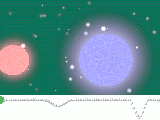ययाति तारामंडल तारे इन्हें भी देखें सन्दर्भ दिक्चालन सूची"Astrophysics: Stars and Galaxies"

Multi tool use
ययाति तारामंडलतारामंडल
अंग्रेज़ीखगोलीय गोलेतारामंडलटॉलमीअंतर्राष्ट्रीय खगोलीय संघबायर नामपरिवर्ती ताराबायर नामग़ैर-सौरीय ग्रह
ययाति तारामंडल
Jump to navigation
Jump to search

ययाति (पर्सियस) तारामंडल

अलग़ोल (बेटा परसई) तारे की चमक तब घटती है जब मुख्य तारे के आगे एक कम रोशन साथी तारा आ जाता है
ययाति या पर्सियस (अंग्रेज़ी: Perseus) तारामंडल खगोलीय गोले के उत्तरी भाग में दिखने वाला एक तारामंडल है।[1] दूसरी शताब्दी ईसवी में टॉलमी ने जिन ४८ तारामंडलों की सूची बनाई थी यह उनमें से एक है और अंतर्राष्ट्रीय खगोलीय संघ द्वारा जारी की गई ८८ तारामंडलों की सूची में भी यह शामिल है। ययाति तारामंडल में अलग़ोल (बायर नाम: β Per) नाम का मशहूर परिवर्ती तारा स्थित है। वार्षिक पर्सिड उल्कापिंडों की बौछार भी आकाश के इसी क्षेत्र में होती है।
तारे
ययाति तारामंडल में छह मुख्य तारे हैं, हालांकि वैसे इसमें 65 तारों को बायर नाम दिए जा चुके हैं। इनमें से छह के इर्द-गिर्द ग़ैर-सौरीय ग्रह परिक्रमा करते हुए पाए गए हैं। इस तारामंडल के मुख्य तारे और अन्य वास्तुएँ इस प्रकार हैं -
अल्फ़ा परसई (α Persei) - पृथ्वी से लगभग 590 प्रकाश-वर्ष दूर स्थित एक पीले-सफ़ेद रंग का महादानव तारा है। इसे मिर्फ़क और अल-जनिब के नाम से भी जाना जाता है। इसके श्रेणी F5Ib है।
मायावती या बेटा परसई (β Persei) - यह पृथ्वी से 93 प्रकाश-वर्ष दूर स्थित एक परिवर्ती तारा है जो अपनी चमक वैसे तो 2.1 मैग्नीट्यूड पर रखता है और पर हर 2 दिन, 20 घंटे और 49 मिनट बाद उसे कम करके 3.4 मैग्नीट्यूड कर लेता है। यह वास्तव में तीन तारों का मंडल है। इसकी चमक तब कम होती है जब सब से बड़े मुख्य तारे के आगे उस से कम रौशनी वाला एक साथी तारा आ जाता है। इसके मुख्य तारे की श्रेणी B8V है।
ऍम34 (M34) नाम का खुला तारागुच्छ जो पृथ्वी से 1,400 प्रकाश-वर्ष दूर लगभग 100 तारों का गुच्छा है।
ऍन॰जी॰सी॰ 1260 (NGC 1260) - एक सर्पिल (स्पाइरल) आकाशगंगा जिसमें ऍस॰ ऍन॰ 2006जी॰वाई॰ (SN 2006gy) नामक महानोवा (सुपरनोवा) है जो पूरे ब्रह्माण्ड में देखी गई दूसरी सब से रोशन वस्तु है।
पर्सियस आणविक बादल (Perseus Molecular Cloud) - एक आणविक बादल जिसमें बहुत कम संख्या में तारे बन रहे हैं।
इन्हें भी देखें
- अल्फ़ा परसई तारा
- तारामंडल
सन्दर्भ
↑ K.D. Abhyankar. "Astrophysics: Stars and Galaxies". Universities Press, 2002. आई॰ऍस॰बी॰ऍन॰ 9788173713811..mw-parser-output cite.citationfont-style:inherit.mw-parser-output qquotes:"""""""'""'".mw-parser-output code.cs1-codecolor:inherit;background:inherit;border:inherit;padding:inherit.mw-parser-output .cs1-lock-free abackground:url("//upload.wikimedia.org/wikipedia/commons/thumb/6/65/Lock-green.svg/9px-Lock-green.svg.png")no-repeat;background-position:right .1em center.mw-parser-output .cs1-lock-limited a,.mw-parser-output .cs1-lock-registration abackground:url("//upload.wikimedia.org/wikipedia/commons/thumb/d/d6/Lock-gray-alt-2.svg/9px-Lock-gray-alt-2.svg.png")no-repeat;background-position:right .1em center.mw-parser-output .cs1-lock-subscription abackground:url("//upload.wikimedia.org/wikipedia/commons/thumb/a/aa/Lock-red-alt-2.svg/9px-Lock-red-alt-2.svg.png")no-repeat;background-position:right .1em center.mw-parser-output .cs1-subscription,.mw-parser-output .cs1-registrationcolor:#555.mw-parser-output .cs1-subscription span,.mw-parser-output .cs1-registration spanborder-bottom:1px dotted;cursor:help.mw-parser-output .cs1-hidden-errordisplay:none;font-size:100%.mw-parser-output .cs1-visible-errorfont-size:100%.mw-parser-output .cs1-subscription,.mw-parser-output .cs1-registration,.mw-parser-output .cs1-formatfont-size:95%.mw-parser-output .cs1-kern-left,.mw-parser-output .cs1-kern-wl-leftpadding-left:0.2em.mw-parser-output .cs1-kern-right,.mw-parser-output .cs1-kern-wl-rightpadding-right:0.2em
श्रेणियाँ:
- ययाति तारामंडल
- तारामंडल
(RLQ=window.RLQ||[]).push(function()mw.config.set("wgPageParseReport":"limitreport":"cputime":"0.116","walltime":"0.141","ppvisitednodes":"value":95,"limit":1000000,"ppgeneratednodes":"value":0,"limit":1500000,"postexpandincludesize":"value":1867,"limit":2097152,"templateargumentsize":"value":0,"limit":2097152,"expansiondepth":"value":4,"limit":40,"expensivefunctioncount":"value":0,"limit":500,"unstrip-depth":"value":1,"limit":20,"unstrip-size":"value":2909,"limit":5000000,"entityaccesscount":"value":0,"limit":400,"timingprofile":["100.00% 101.073 1 साँचा:Reflist","100.00% 101.073 1 -total"," 91.27% 92.254 1 साँचा:Cite_web"],"scribunto":"limitreport-timeusage":"value":"0.056","limit":"10.000","limitreport-memusage":"value":1404552,"limit":52428800,"cachereport":"origin":"mw1272","timestamp":"20190917205238","ttl":2592000,"transientcontent":false););"@context":"https://schema.org","@type":"Article","name":"u092fu092fu093eu0924u093f u0924u093eu0930u093eu092eu0902u0921u0932","url":"https://hi.wikipedia.org/wiki/%E0%A4%AF%E0%A4%AF%E0%A4%BE%E0%A4%A4%E0%A4%BF_%E0%A4%A4%E0%A4%BE%E0%A4%B0%E0%A4%BE%E0%A4%AE%E0%A4%82%E0%A4%A1%E0%A4%B2","sameAs":"http://www.wikidata.org/entity/Q10511","mainEntity":"http://www.wikidata.org/entity/Q10511","author":"@type":"Organization","name":"Contributors to Wikimedia projects","publisher":"@type":"Organization","name":"Wikimedia Foundation, Inc.","logo":"@type":"ImageObject","url":"https://www.wikimedia.org/static/images/wmf-hor-googpub.png","datePublished":"2011-08-07T02:42:15Z","dateModified":"2016-10-15T22:51:15Z","image":"https://upload.wikimedia.org/wikipedia/commons/b/b8/Perseus_IAU.svg"(RLQ=window.RLQ||[]).push(function()mw.config.set("wgBackendResponseTime":105,"wgHostname":"mw1272"););C Ab GD0mq lEFVsznZJ